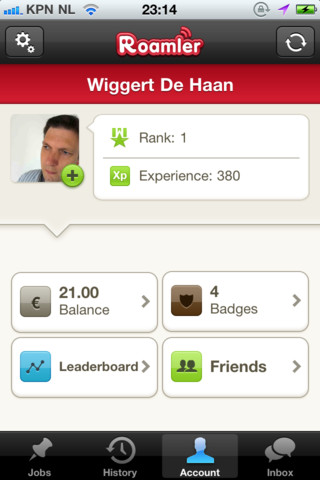App review: Roamler
On June the 10th of this year the Amsterdam startup Roamler launched their free iPhone-app bearing the same name. Roamler challenges its ‘Roamlers’, the name for the users of the app, to complete certain tasks on assigned locations using their iPhones and in doing so earn cash as well as experience points and badges. With these Roamlers can compete against each other and climb the Roamler ranking, unlocking more complex assignments that offer more money. Some of the assignments can be fulfilled at home (‘make a picture of something red’) though most assignments asks its Roamlers to hit the streets to carry them out (‘make a picture of littering in your city’). The Roamlers’ wage is paid by the companies that make the assignments, using the content provided by the Roamlers for market research. By combining the virtual with the physical, the app is facilitating location based crowdsourcing in that it mobilizes an online workforce that will happily ‘work’ for any company as long as the assignment is fun and the earnings are sufficient.
 Users can download the free app on their iPhones and activate their account using an activation code. Examples of these assignments range from “take a photograph of your refrigerator” to “complete a checklist at a playground in Amsterdam”. Roamler sends out their assignments using GPS. Heineken for instance once had a stand on a festival and wanted Roamlers to take photographs of it. Roamlers that were in the neighborhood got a message asking them to complete the assignment. Roamlers that did, sends these pictures to Roamler via the app. When the assignment is approved Roamler then pays their Roamlers the amount they’ve earned through PayPal. Aside from the money Roamlers also receive experience points and badges like in Foursquare. When a Roamler completes many assignments in a certain period he or she goes up in the Roamlers ranking, enabling them to compete for better assignments that are either more fun or makes it possible to earn more money. This game element is important for Roamler because it causes the users to stay active and sharp.
Users can download the free app on their iPhones and activate their account using an activation code. Examples of these assignments range from “take a photograph of your refrigerator” to “complete a checklist at a playground in Amsterdam”. Roamler sends out their assignments using GPS. Heineken for instance once had a stand on a festival and wanted Roamlers to take photographs of it. Roamlers that were in the neighborhood got a message asking them to complete the assignment. Roamlers that did, sends these pictures to Roamler via the app. When the assignment is approved Roamler then pays their Roamlers the amount they’ve earned through PayPal. Aside from the money Roamlers also receive experience points and badges like in Foursquare. When a Roamler completes many assignments in a certain period he or she goes up in the Roamlers ranking, enabling them to compete for better assignments that are either more fun or makes it possible to earn more money. This game element is important for Roamler because it causes the users to stay active and sharp.
Background
Roamler is founded by Martijn Nijhuis en Wiggert de Haan who were working together at the market Research bureau Isiz. In December 2010 the two where working on a project for a client specialized in billboard advertising. Discussing the foundation of the company in an interview on Frankwatching.com: “We approached it pretty 1.0: we simply asked people to take surveys on the street. As iPhone-enthusiasts we figured that in these times this should be able to be executed in a quicker, smarter and most of all funnier way. It was this notion that lead us to think about a location based crowdsource app. We immediately started building our business case, looking for launching partners and putting together a team. And now, a half year later, there’s Roamler!”
First Fifty
 In the weeks after the launch fifty people where invited by Roamler to test the app. These ‘First Fifty’ consists of – probably considered influential – bloggers, journalists and students. Roamler launched the app with launching-partner Heineken, asking these first Roamlers to go on a search for the new Heineken Coolcan in supermarkets and stores and photograph it. With every photo a Roamler earned 2 euros and 60 experience points. The network of Roamler is expanded gradually by the invites users can give away to friends or people they feel should be a Roamler. With this strategy of expanding the network through invites Roamler follows a similar strategy Google+ adopted in launching their new social network service. In this strategy the service is made available to a limited number of people, who then can send a limited number of ‘invites’ to people they know. This snowball method will lead to an expected 10.000 users around September this year. Roamler adopted this model of slow growth to remain exclusive and to be able to manage the network. Despite – or actually because – the fact Roamler isn’t free to all the buzz around the app and the number of people wanting to join is huge. A quick query on ‘Roamler’ shows numerous blogposts and people eagerly wishing, wanting, asking to be invited either by Roamler or the Roamlers. The appeal of joining the Roamler network is so big that invites have become an actual commodity: they are being sold for around 15 euros on the Dutch version of Ebay, Markplaats.nl. Where some Roamlers thus are actually selling their available invites, others address the question of giving out the invite slightly more philanthropic: blogger Chantal Coolsma for example gave away her three possible invites to people that donated a minimum of five euros to a charity of choice.
In the weeks after the launch fifty people where invited by Roamler to test the app. These ‘First Fifty’ consists of – probably considered influential – bloggers, journalists and students. Roamler launched the app with launching-partner Heineken, asking these first Roamlers to go on a search for the new Heineken Coolcan in supermarkets and stores and photograph it. With every photo a Roamler earned 2 euros and 60 experience points. The network of Roamler is expanded gradually by the invites users can give away to friends or people they feel should be a Roamler. With this strategy of expanding the network through invites Roamler follows a similar strategy Google+ adopted in launching their new social network service. In this strategy the service is made available to a limited number of people, who then can send a limited number of ‘invites’ to people they know. This snowball method will lead to an expected 10.000 users around September this year. Roamler adopted this model of slow growth to remain exclusive and to be able to manage the network. Despite – or actually because – the fact Roamler isn’t free to all the buzz around the app and the number of people wanting to join is huge. A quick query on ‘Roamler’ shows numerous blogposts and people eagerly wishing, wanting, asking to be invited either by Roamler or the Roamlers. The appeal of joining the Roamler network is so big that invites have become an actual commodity: they are being sold for around 15 euros on the Dutch version of Ebay, Markplaats.nl. Where some Roamlers thus are actually selling their available invites, others address the question of giving out the invite slightly more philanthropic: blogger Chantal Coolsma for example gave away her three possible invites to people that donated a minimum of five euros to a charity of choice.Clients
